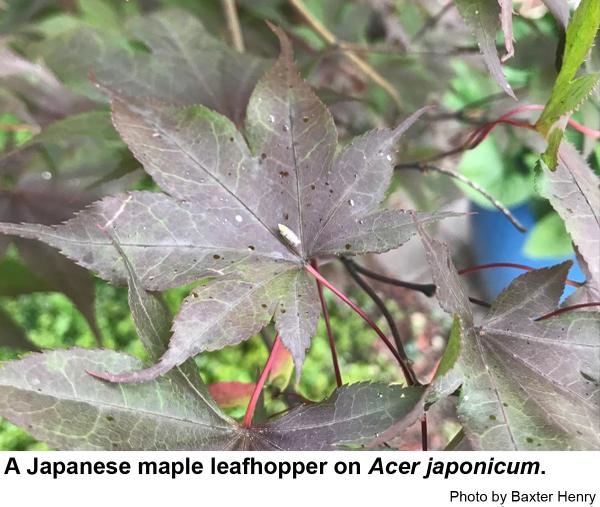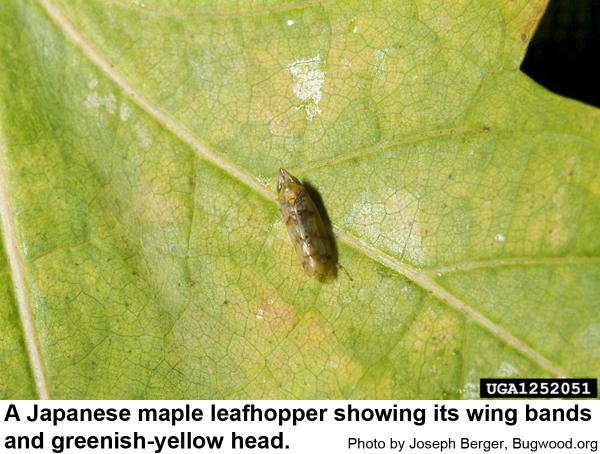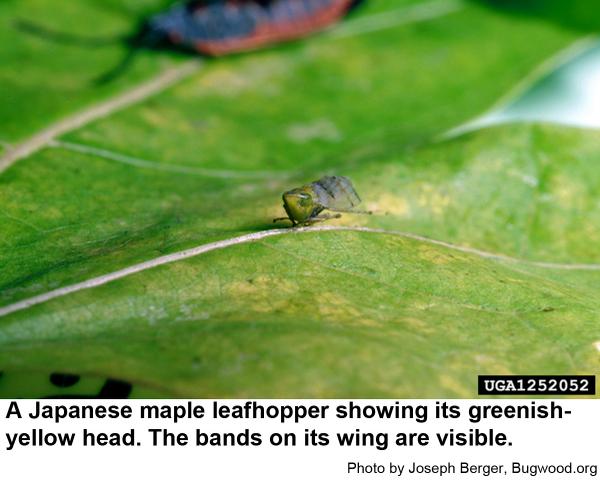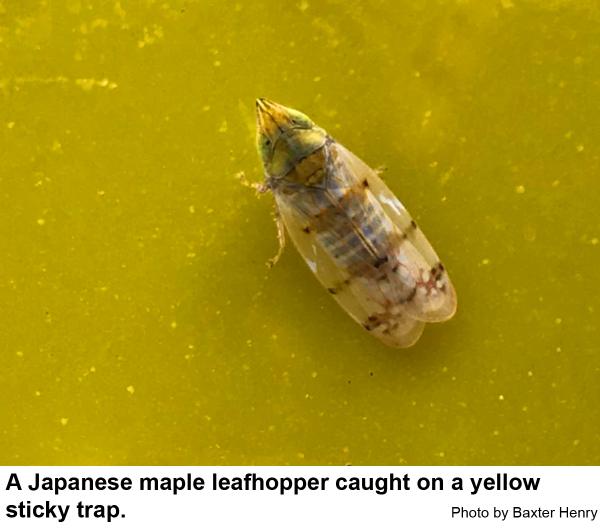Description and Biology
The Japanese maple leafhopper, Japananus hyalinus, has also been called the Asian maple leafhopper. This is a fairly distinctive leafhopper with its greenish-yellow head and whitish/translucent wings that have three rusty to dark brown bands across them. Males are slightly smaller than the 3/16 inch long females. Adult Japanese maple leafhoppers are very active and move readily when disturbed. This leafhopper overwinters as eggs inserted under the bark near buds on the latest twig growth. Eggs are about 1/32 inch long; sometimes tips of eggs actually show through the split in the bark the female makes as she sticks the egg in. Sometime the next spring the eggs hatch and the tiny new nymphs begin to feed from the phloem tissue on the lower surfaces of leaves in the shadier parts of the tree. Nymphs develop through five stages as they grow, and by mid June they molt into adults. When abundant, the activity of Japanese maple leafhoppers sounds like rainfall close to an infested tree! The Japanese maple leafhopper was probably introduced from the Orient on dormant Japanese maple nursery stock sometime in the late 1800's. Adult Japanese maple leafhoppers have been collected from June through October in North Carolina. In more northern areas, it has been reported to have a single generation a year. Because of its long flight period, the Japanese maple leafhopper probably has at least two generations per year here in North Carolina.
Host Plants
The Japanese maples, Acer japonicum and Acer palmatum are readily infested. The Japanese maple leafhopper has also adapted to boxelder, Norway maple, red maple, silver maple, and other maples. Unlike some other leafhoppers, the Japanese maple leafhopper does not seem to produce any signs or symptoms on its host plants.
Residential Recommendations
Because of the wide host range most of which is never sprayed with insecticides, it is not likely that Japanese maple leafhoppers are resistant to pesticides. Most contact insecticides should give more than adequate control. Consider one of the pyrethroids labeled for landscape use should the need to manage this pest arise. When used as directed, pyrethroids are very toxic to insects but are not particularly hazardous to humans and pets (other than fish—avoid using pyrethroids around pools, ponds, and streams).
Other Resources
- Check list of the planthoppers and leafhoppers of Germany, with notes on food plants, diet width, life cycles, geographic range and conservation status (Hemiptera, Fulgoromorpha and Cicadomorpha). Nickel, H. and R. Remane. 2002. Artenliste der Zikaden Deutschlands (An English translation).
- Rapid Pest Risk Analysis (PRA) for Japananus hyalinus. Tuffen, M. et al. 2014. The Food & Envrionment Research Agency (UK).
- 20 records for Japananus hyalinus Wake County. Anonymous. No Date. Hoppers of North Carolina: Spittlebugs, Leafhoppers, Treehoppers, and Planthoppers, NC Biodiversity Project.
- Extension Plant Pathology Publications and Factsheets
- Horticultural Science Publications
- North Carolina Agricultural Chemicals Manual
For assistance with a specific problem, contact your local Cooperative Extension Center.
This Factsheet has not been peer reviewed.
Publication date: June 18, 2019
Revised: Sept. 25, 2019
Recommendations for the use of agricultural chemicals are included in this publication as a convenience to the reader. The use of brand names and any mention or listing of commercial products or services in this publication does not imply endorsement by NC State University or N.C. A&T State University nor discrimination against similar products or services not mentioned. Individuals who use agricultural chemicals are responsible for ensuring that the intended use complies with current regulations and conforms to the product label. Be sure to obtain current information about usage regulations and examine a current product label before applying any chemical. For assistance, contact your local N.C. Cooperative Extension county center.
N.C. Cooperative Extension prohibits discrimination and harassment regardless of age, color, disability, family and marital status, gender identity, national origin, political beliefs, race, religion, sex (including pregnancy), sexual orientation and veteran status.




